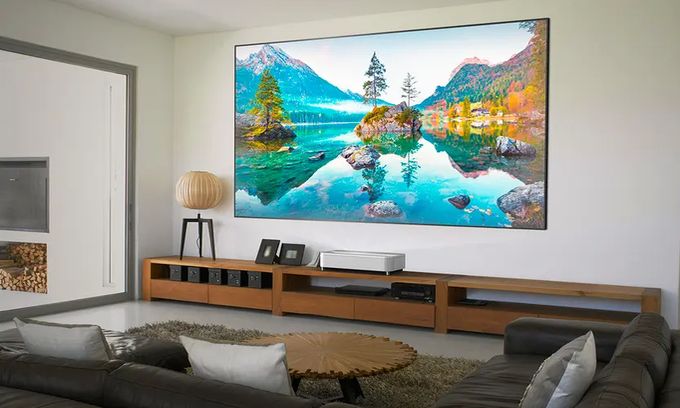In 2017, the LG PF1000U became the first UST (Ultra Short Throw) Home Theater projector. Since then their popularity has been growing rapidly. Unlike traditional mid-focal models, its aspherical lense-based optical system form a projection from 100″ from a distance of several tens of inches.
Placing close to the screen solved the main problem of mid-focal projectors, the throw distance of which is several meters. Their placement in the room center creates a problem of wires on the floor, and a ceiling mount is troublesome. New optical system has radically solved this problem, paving the way for UST projectors as an alternative with to TVs in living rooms.
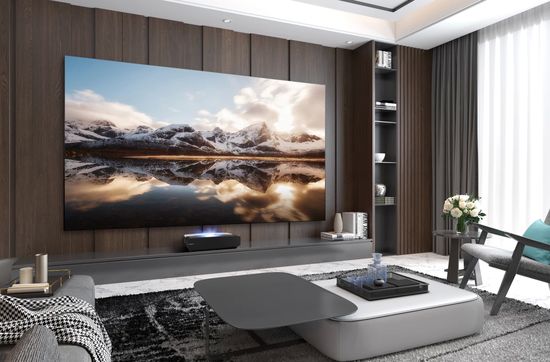
To be fair, the projectors had other problems, including:
– large dimensions and noise due to a powerful fan that cools the lamp used as a light source.
Solid State Light (SSL) sources, including LED, laser-phosphor (ALPD 3.0 or Advanced Laser Phosphor Display technology) and triple-laser RGB (ALPD 4.0) light engines have virtually replaced lamp projectors. Unlike lamps, they practically do not heat up and do not require powerful fans for cooling. But to be honest, the heating and price of modern lamps has also drastically decreased. For example, the noise of the latest BenQ TK860i is ~30 dB, which corresponds to a whisper, and the price of its metal halide bulb is less than $50;
– limited content.
The wireless technologies for screen mirroring and streaming have eliminated the problem of limited content;
– brightness and resolution is significantly lower vs TVs.
Brightness and resolution
The projector image brightness is significantly lower vs TV. This is due to an objective reason. Unlike a re-reflected image of projector, the TV uses a direct light output. As a result, even powerful and expensive projectors deliver several hundred nits on the screen. But the brightness of even budget modern TVs usually exceeds 500 nits.
But it’s critical only to HDR performance and compensate for ambient light, which makes the picture faded and dull. In addition, the brightness of modern projectors usually exceeds 2,000 ANSI Lumens, which is quite enough for acceptable image quality even in weak diffused daylight.
HDR performance is also not yet relevant due to the limited HDR content. Due to limited network bandwidth, almost all cable and satellite TV offers only SDR content.
Pixel shift has successfully solved the resolution problem, opening the way to the market for low-cost projectors with 1080p chipsets. This technology was first used by JVC in 2013 to enhance the image resolution of their D-ILA chips. Of course, other industry leaders were not left out, and Epson soon developed its own 4K Enhancement version for (1,920 x 1,080) 3LCD chips. Then Texas Instruments introduced DMD (Digital Micromirror Device) chipsets with XPR technology ( .66″ and .47″ DLP 4K UHD chips).
This idea is simple, but captivates with its elegance. In fact, the projector divides the 8 million pixels of the original 4K content into 4 parts, and sequentially reproduces them with a shift of half a pixel using only 2 million micromirrors of the 1080p chipset.
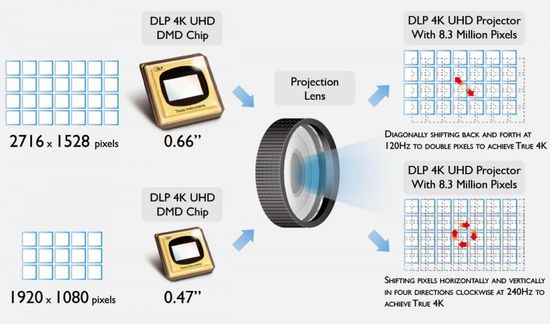
Changing the lens tilt with 4 electromagnets of the XPR module provides a shift of the pixels on the screen. Due to the high frequency, the eye and brain perceive 4 images as one clearer picture.
UST projectors vs TVs
As a result, UST laser projecors are gradually pushing TVs out of living rooms. Of course, modern OLED, QD-OLED and QLED miniLED TVs provide better picture quality due to the higher brightness, native contrast, resolution and wider color gamut. But their price ranges from $ 2,000 to $ 3,000 for 65-inch models. For the same price, 4K laser UST projectors offer huge screen sizes at slightly lower image quality. Moreover, in the evening, when there is no ambient lighting, this difference practically disappears. Finally, mobility is an added bonus in projector favor.
The companies adequately respond to consumer conjuncture, annually expanding their UST range. The list of newest models this year includes:
– Hisense ‘Laser TV’ and ‘Laser Cinema’ series, including L9H, L5H, PL1, PX2 Pro, etc;
– announced BenQ V5000i;
– Visionair-e 3000, etc.
Of course, Epson also offers a wide range of UST projectors. At the 2022 CEDIA Expo in Dallas, Epson unveiled the EpiqVision Ultra LS800, which replaced the popular LS500. At InfoComm 2023 in Florida, the Japanese giant unveiled the PowerLite 810E UST 4K (V11HA99080). Its specs and price are almost identical to the EpiqVision Ultra LS800. Depending on the sales region, the PowerLite 810E may become its European version.
Both models use 3-chip 3LCD technology with the same color & white brightness, ALPD 3.0-based laser phosphor light engine, support 2,500,000:1 dynamic contrast ratio, and provide (203-382cm) / (80″-150″) Image Size from (30-60cm) / (12″-23″) Throw Distance at 0.16:1 Throw Ratio (100″@16″).

Models cost $ 3,120 and $ 3,300 (LS800 vs 810E). Considering the traditional correction of the launch price, in the autumn they may equalize. In fact, brightness is their main difference.
Epson projectors brightness
This aspect requires some explanation. Brightness is one of the main projector specs and companies are actively using it for marketing purposes. As known, 3LCD technology do not use a color wheel, producing an image without colors loss. As a result, Epson projectors always deliver the same white brightness and CLO (color light output).
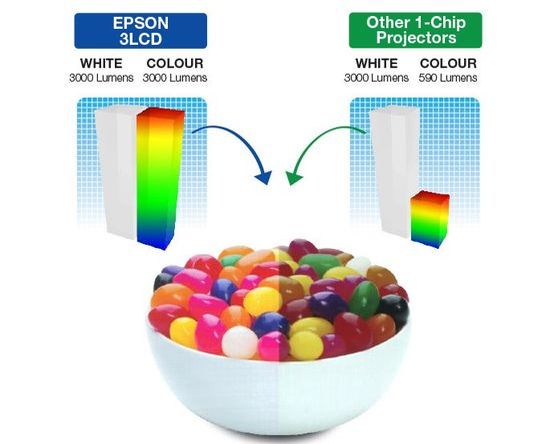
Of course, the company focuses the attention on this aspect, indicating white brightness and CLO in the specs. Some LED projector manufacturers use LED lumens. In their opinion, they are more informative, because they take into account the brightness perceived by the eye. Most companies prefer traditional ANSI (American National Standards Institute) lumens measured at 9 screen points. To avoid confusion, some companies don’t list the brightness/light output at all.
In recent models, Epson uses ISO lumens. For reference, ISO is an acronym for International Organization for Standardization. In fact, ANSI lumens define method of measuring the projector luminous flux, and ISO lumens is the standard by ISO 21118 regulation. It specifies the production standard of the projector and the measurement test standard, including the light source power and the noise effect on brightness.
EH-LS800B:
– 4,000 Lumens in accordance with IDMS15.4 (CLO) and ISO 21118:2020 (white) on the company website or 4,000 ANSI lumens in other sources.
EB-810E:
– 5,000 Lumens in accordance with IDMS15.4 (CLO) and ISO 21118:2020 (white) on the company website or 5,000 ANSI lumens in other sources.
Perhaps the information on the site is more priority and the indicated brightness is 4,000 ISO lumens and 5,000 ISO lumens, respectively. Considering the conversion factor (1 ISO lumens ~ 0.8 ANSI lumens), their brightness reaches 3,200 and 4,000 ANSI lumens, which is a very high value. Either way, the EB-810E is 20% brighter.
Some key features
Color modes (EB-810E vs EH-LS800B):
– Dynamic, Natural, Cinema, Presentation, Blackboard, DICOM SIM, Multi Projection (Video Color Mode) vs Dynamic, Natural, Cinema, Vivid.
For reference, DICOM SIM simulates DICOM (Digital Imaging and Communication in Medicine) standard for handling, storing, printing and transmitting medical imaging information. Blackboard adjusts the colors and is ideal for presentations into a green chalkboard. Multi-Projection generates one large and/or wide image from multiple projectors.
Both models use .62″ LCD chips with C2 Fine, 10-bits color video processing, support HDR10 and HLG.
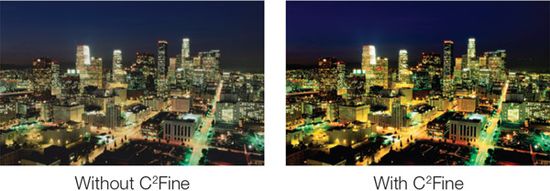
The EB-810E supports Miracast screen mirroring (multi-device content transfer), multiple aspect ratios and multi-projector edge-blending for video conferencing. EH-LS800B offers Android TV and sound by Yamaha.
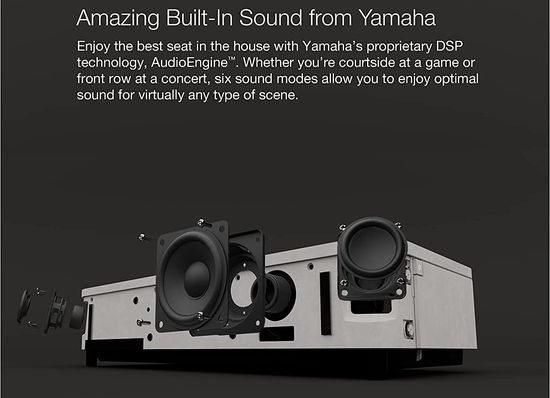
EB-810E feature list includes 21:9 aspect ratio support, Arc Correction, Auto Power On, Customizable user logo, Daisy chain Multi-Projection, Digital zoom, Document Camera Compatible, Edge Blending, Email notification, Fit to Screen, Home Screen, Horizontal and vertical keystone correction, Image Shift, JPEG Viewer, Ultra-wide display (16:6), etc.
With a 0.16:1 Throw Ratio, the projector produces an 80″ projection with only 1″ (~3 cm) distance between the front panel and the screen. On this basis, the company is positioning the projector as Extreme Short Throw. Sure, 0.16:1 is impressive, but the Extreme Short Throw (EST) classification is unlikely to replace the traditional Ultra Short Throw (UST) name.
Of course, its brightness, price and functionality are more suitable for use in classrooms or meeting rooms. But with a good budget, it can be a great choice for a Home Theater.
Conclusion
Perhaps comparing the PowerLite business series with the EpiqVision Home Theater is not very correct. But with the exception of brightness, the EB-810E and EH-LS800B have nearly identical specs and price. Moreover, the company positions a new model as a projector with ‘hybrid working solutions’.
At the same price of ~$ 3,200, the new EB-810E is 20% brighter and more functional. Android TV and sound by Yamaha in EH-LS800B are more in line with the classification of Home Theater. The extra brightness of the EB-810E can be a significant bonus when using the projector on a glazed veranda. But in general, both models are great for any purpose.
The video demonstrates the announcement of the EB-810E on ISE 2023.
